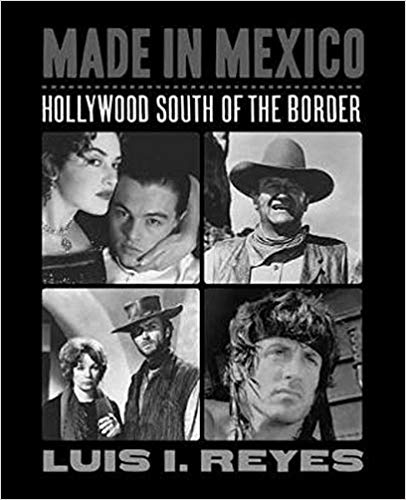 Umberto Eco writing of lists insisted that “the infinity of aesthetics is the subjective feeling of something greater than us. It is an emotional condition, a potential infinity.” Indeed, Reyes’ text in Made in Mexico: Hollywood South of the Border (Applause Books, August 2018), in reference to over 660 movies, can feel infinite, and his enumeration is not a precise dictionary. His approach exploring Hollywood’s connection to Mexico is by no way restricted to Studio movies made in Mexico as he expands his examination to include Hollywood’s influence on the Mexican film industry and Mexican culture, as well as Mexican actors and directors who’ve found success north of the border and even notable American dalliances in Mexico. No excuse for discarding an interesting anecdote was considered.
Umberto Eco writing of lists insisted that “the infinity of aesthetics is the subjective feeling of something greater than us. It is an emotional condition, a potential infinity.” Indeed, Reyes’ text in Made in Mexico: Hollywood South of the Border (Applause Books, August 2018), in reference to over 660 movies, can feel infinite, and his enumeration is not a precise dictionary. His approach exploring Hollywood’s connection to Mexico is by no way restricted to Studio movies made in Mexico as he expands his examination to include Hollywood’s influence on the Mexican film industry and Mexican culture, as well as Mexican actors and directors who’ve found success north of the border and even notable American dalliances in Mexico. No excuse for discarding an interesting anecdote was considered.
Culture is of special interest to Reyes and he does offer the “masked wrestler adventure film genre, lucha libre” as uniquely Mexican. Jack Black’s Nacho Libre (2006) is the closest American equivalent to more than 50 El Santo movies, El Santo acting as a sort of low-powered super-folk-hero. But otherwise, American and Mexican sensibilities blend nicely.
From The Life of General Vida (1914, although imdb offers up a few earlier shorts, including an alternate 1912 Life of Villa by the same director—both versions sadly lost) to Godzilla: King of the Monsters (2019, in theaters May 31st) Reyes touches on the many movies filmed, at least in part, in Mexico. Some entries, such as The Fugitive (RKO’s 1947 adaptation of The Power and The Glory) are reassuring. (Greene’s book was set in Mexico.) Others shock: the 1997 Oscar winning epic Titanic would use the Pacific Ocean as the Atlantic’s body-double (and belie Reyes’ claim that Mexican filming costs were always more reasonable). Movies are listed for every taste. I’m drawn to Tarzan and the Mermaids (1948) featuring the beaches of Acapulco and Mex-afri-cans and The Devil’s Rain (1975) which paired John Travolta (in his first feature film) with actual Satanists (like Anton LeVey) under the devilish Ernest Borgnine, all threatening William Shatner. Who wouldn’t enjoy that cast?
Emilio Fernandez, producer on The Fugitive, also starred (among his many other roles) as the male lead in La Cucaracha (1959, his was third billing after two female stars) but is probably best known as a director—his Maria Candelaria won the top prize at Cannes in 1946; it would be redubbed in English and released by MGM. Mexican directors play a great part of the story. Who can ignore recent Academy Award Best Director winners Alfonso Cuarón (Gravity, 2013), Alejandro Gonzalez Iñárritu (Birdman, 2014 and The Revenant, 2015), and Guillermo del Toro (The Shape of Water, 2017)? For those collecting trivia, their Oscar statues were, in fact, modeled in 1928 after a naked Emilio Fernandez.
Other nudity creeps into Reyes’ narrative. His account of Marilyn Monroe’s shopping holiday in Mexico suggests a possible inspiration for Sharon Stone’s famous leg-uncross in Basic Instinct, a detail that seems gratuitous despite his report that she was buried just a few months later “in the short, lime-green Emilio Pucci dress she wore at the press conference in Mexico.”
For Eco, lists may be practical, pragmatic, or poetic. Reyes’ Made in Mexico is certainly the latter, a literary list that, while finite, extends connections outwards in all directions and suggests viewing for many nights to come.


